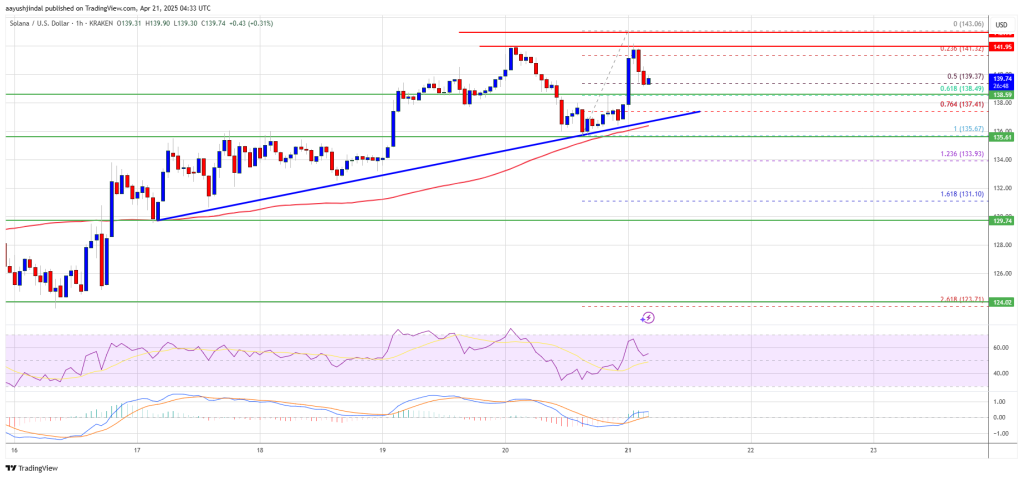Market
Render (RNDR) Price Strengthens, Yet Challenges Remain

Render (RNDR) price has surged by 26% over the last week, establishing it as a key player in the booming crypto AI sector. However, despite this strong price growth, RNDR is lagging behind its top competitors in critical metrics like social dominance and trading volume. Tokens such as FET, TAO, and WLD have captured more market attention, raising questions about RNDR’s long-term momentum.
Indicators, including the Bollinger Bands Trend and Global In/Out of the Money, signal that RNDR may face significant resistance ahead. As the coin’s upward momentum begins to cool, the next few weeks will be crucial for RNDR’s price.
Is RNDR Being Left Behind In the Crypto AI Race?
RNDR has solidified its position as one of the most prominent players in the crypto AI space, riding on the wave of increased interest in artificial intelligence coins. Over the last seven days, RNDR’s price has seen an impressive 26% increase, reflecting strong market demand. However, when placed alongside the top five AI coins, the picture becomes more complex.
Despite its ranking as the third-largest AI token by market cap, RNDR ranks only fourth in terms of social dominance. That suggests it’s not garnering the same level of attention or hype as some of its competitors. Players like FET, TAO, and WLD have captured more of the public’s focus, leaving RNDR to compete for visibility, only outperforming AKT in terms of attention.
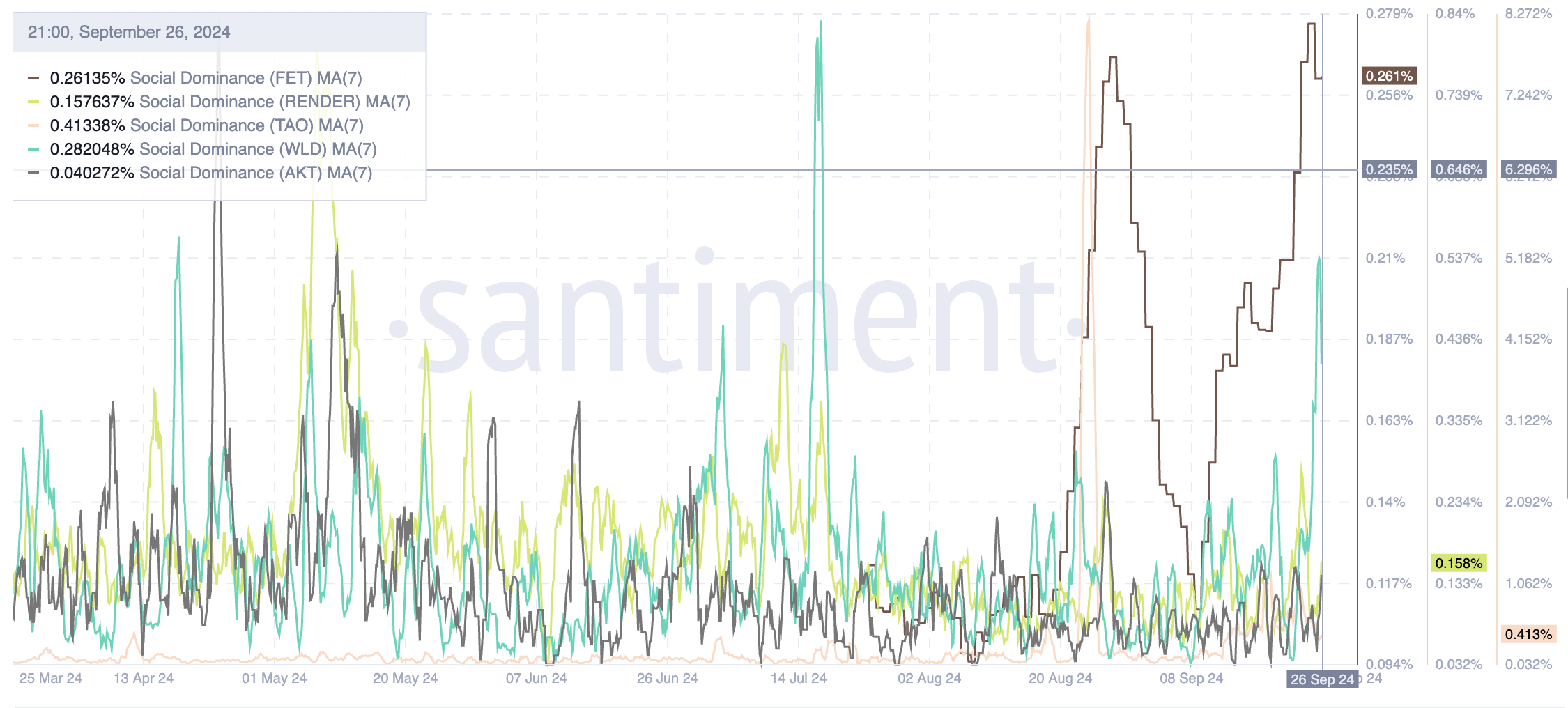
This underperformance in social dominance aligns with its relative price growth. Over the past month, RNDR has risen by 19%, a respectable gain but still lagging significantly behind FET (up 39.84%), TAO (up 81.52%), and WLD (up 37.27%).
Once again, RNDR only outpaces AKT, which trails behind the rest. The same trend can be observed when looking at trading volume.
Read More: Render Token (RNDR) Price Prediction 2024/2025/2030
While RNDR attracted $2.25 billion in trading volume last month, this figure is notably lower than that of FET, TAO, and WLD. This suggests that the broader market interest and liquidity are flowing more heavily toward its competitors.
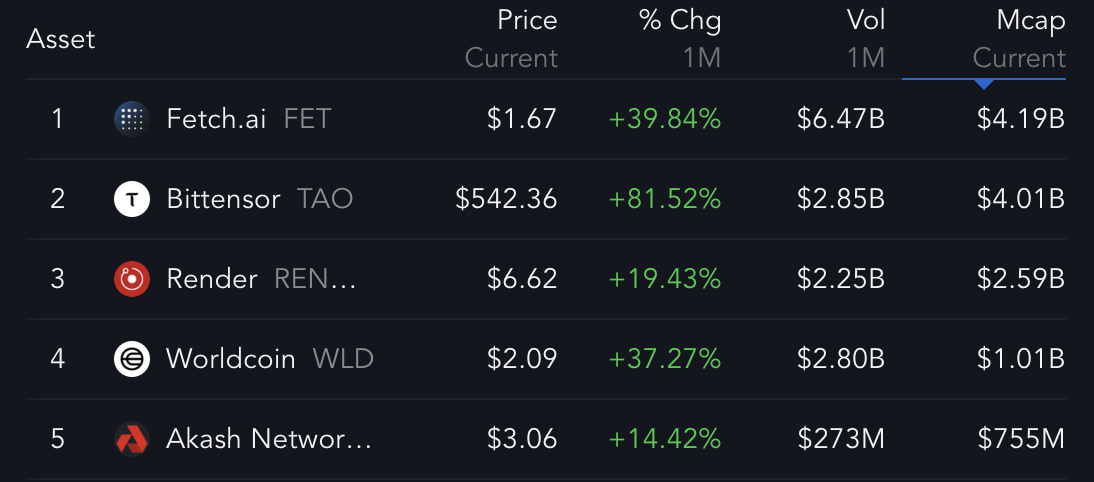
These dynamics indicate that while RNDR is undeniably a key player in the AI and crypto segment, it is struggling to maintain momentum against its fiercest rivals. This disparity in social engagement, price performance, and volume could signal potential headwinds for RNDR price in the near future.
Without a significant uptick in market attention or renewed catalysts to drive interest, RNDR’s current underperformance relative to its competitors might dampen its price trajectory in the weeks to come. In a market as sentiment-driven as crypto, the ability to capture attention is crucial. RNDR’s comparative lack of visibility could hinder its long-term performance despite its possible solid fundamentals.
RNDR Bollinger Bands Trend Could Be Cooling Off
The Bollinger Bands Trend (BBTrend) for RNDR has remained positive for the last six days, rising sharply from 0.36 to 18, mirroring its recent price growth.
Bollinger Bands Trend is a technical indicator used to measure market volatility and trend strength. It is based on the concept of Bollinger Bands, which plot two standard deviations away from a moving average.
When prices are consistently near the upper band, it suggests a strong bullish trend. However, a move toward the lower band can indicate potential bearishness.
The BBTrend specifically looks at how the bands are expanding or contracting to signal whether volatility is increasing or decreasing, which often hints at potential price movements.

While the BBTrend has shown positive growth recently and is still positive, around 12, it has started to decline in the last few days. This drop in the indicator could be a warning sign that the upward momentum might be slowing down.
If the BBTrend continues to decrease, it may suggest a potential shift in the current price trend. This shift may signal a reversal or consolidation period for RNDR.
On the other hand, if the BBTrend recovers and turns back upward, it could reinforce the bullish momentum. This shift may lead to further price gains. The coming days will be crucial in determining whether RNDR can maintain its positive trend.
RNDR Price Prediction: Correction Ahead?
The RNDR Global In/Out of the Money (GIOM) indicator reveals strong resistance levels ahead, particularly in the $6.72 to $8 range. This range indicates that a significant number of RNDR holders purchased at these price levels. As a result, there could be potential selling pressure when the price approaches these points.
GIOM is a key metric that shows how many token holders are either “in the money” (holding tokens at a profit based on current prices) or “out of the money” (holding tokens at a loss). If RNDR can break through the $7 mark, it could potentially test higher levels at $8.03 and even $9.91.
Read More: How To Buy Render Token (RENDER) and Everything You Need To Know
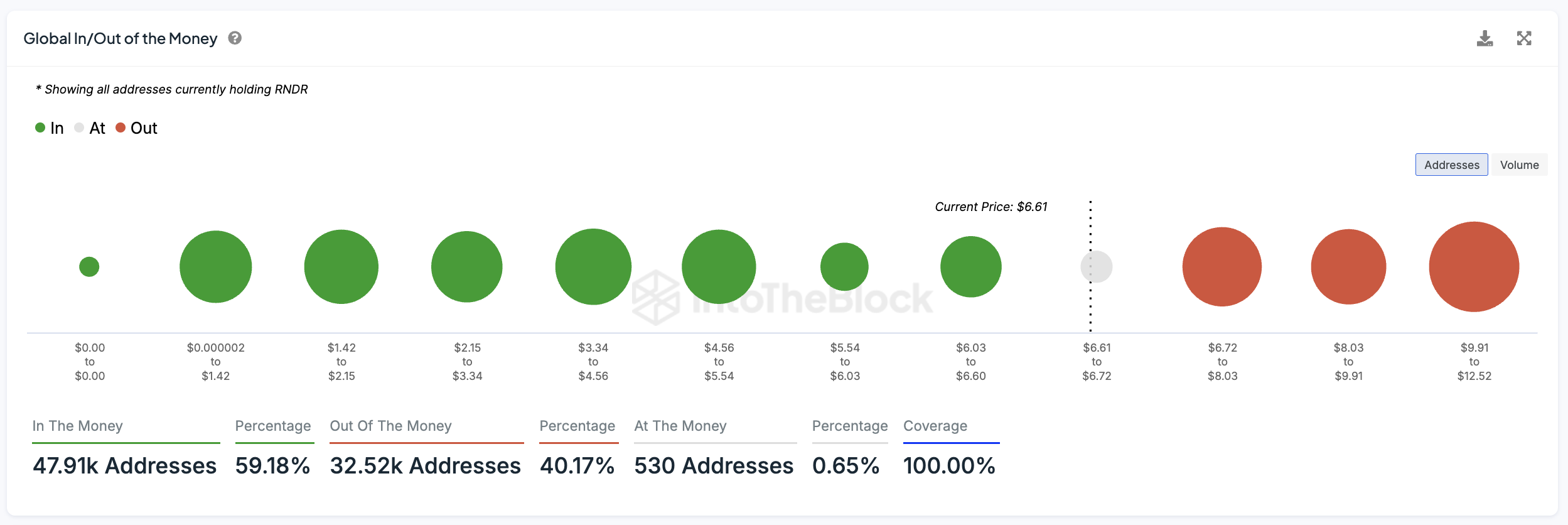
When many holders are in the money at a certain price level, it often forms a resistance point, as they may sell to secure profits. Conversely, when a large portion of holders are out of the money at lower price levels, this forms support. That happens because fewer are willing to sell at a loss, limiting downward pressure.
On the downside, RNDR price support levels appear weaker. If the price drops to $6.03, it could retrace further, potentially sliding to $5.54 or even below $5. This suggests that RNDR has stronger barriers to overcome on the upside than it does on the downside.
Disclaimer
In line with the Trust Project guidelines, this price analysis article is for informational purposes only and should not be considered financial or investment advice. BeInCrypto is committed to accurate, unbiased reporting, but market conditions are subject to change without notice. Always conduct your own research and consult with a professional before making any financial decisions. Please note that our Terms and Conditions, Privacy Policy, and Disclaimers have been updated.
Market
Vitalik Buterin Proposes to Replace EVM with RISC-V

Ethereum (ETH) co-founder Vitalik Buterin has proposed overhauling the blockchain’s smart contract infrastructure by replacing the Ethereum Virtual Machine (EVM) with RISC-V, a widely adopted open-source instruction set architecture.
This shift aims to address one of Ethereum’s key scaling bottlenecks by dramatically improving the efficiency and simplicity of smart contract execution.
Buterin Proposes Ditching EVM for RISC-V
The proposal was detailed in a post on the Ethereum Magicians forum. In it, Buterin suggested that smart contracts could eventually be compiled to RISC-V rather than EVM bytecode.
According to Buterin, this shift addresses long-term scalability challenges. This particularly includes keeping block production competitive and improving zero-knowledge (ZK) EVM-proof efficiency.
“It aims to greatly improve the efficiency of the Ethereum execution layer, resolving one of the primary scaling bottlenecks, and can also greatly improve the execution layer’s simplicity – in fact, it is perhaps the only way to do so,” he wrote.
Current ZK-EVM implementations spend around half of their proving cycles on EVM execution. By switching to a native RISC-V VM, Ethereum could potentially achieve up to 100x efficiency gains.
Importantly, many fundamental aspects of Ethereum’s architecture would remain unchanged, preserving continuity for developers and users. Core abstractions such as accounts, smart contract storage, ETH balances, and cross-contract calls would function exactly as they do today.
Developers would still write contracts in familiar languages like Solidity or Vyper. These would simply be compiled to RISC-V rather than EVM bytecode. Tooling and workflows would remain largely intact, ensuring a smooth transition.
Crucially, the proposal ensures backward compatibility. Existing EVM contracts will remain fully operational and interoperable with new RISC-V contracts.
Buterin outlines several potential implementation paths forward. The first would support both EVM and RISC-V smart contracts natively. The second suggests wrapping EVM contracts to run via an interpreter written in RISC-V. Thus, it would enable a full transition without breaking compatibility.
The third, more modular approach, builds on the second by formally enshrining interpreters as part of the Ethereum protocol. This would allow the EVM and the future virtual machines to be supported in a standardized way.
Buterin stated that the idea is “equally as ambitious as the beam chain effort.”
“The beam chain effort holds great promise for greatly simplifying the consensus layer of Ethereum. But for the execution layer to see similar gains, this kind of radical change may be the only viable path,” Buterin added.
For context, the Ethereum Beam Chain is a redesign of Ethereum’s consensus layer (Beacon Chain). It focuses on faster block times, faster finality, chain snarkification, and quantum resistance. The development will likely begin in 2026.
This proposal fits into Ethereum’s broader vision of modularity, simplicity, and long-term scalability. Previously, BeInCrypto reported on Buterin’s privacy-centric plans for the blockchain.
The proposal focused on integrating privacy-preserving technologies. Moreover, the Pectra upgrade is also nearing, with the launch expected on May 7.
Meanwhile, ETH continues to face market headwinds, trading at March 2023 lows. This year has been quite hard for the altcoin, as it saw a decline of 50.8%. In fact, Ethereum dominance hit a 5-year low last week.

Nonetheless, BeInCrypto data showed a slight recovery over the last 14 days. ETH rose by 6.1%. Over the past day alone, it saw modest gains of 1.7%. At the time of writing, ETH was trading at $1,639.
Disclaimer
In adherence to the Trust Project guidelines, BeInCrypto is committed to unbiased, transparent reporting. This news article aims to provide accurate, timely information. However, readers are advised to verify facts independently and consult with a professional before making any decisions based on this content. Please note that our Terms and Conditions, Privacy Policy, and Disclaimers have been updated.
Market
Solana Rallies Past Bitcoin—Momentum Tilts In Favor of SOL

Solana started a fresh increase from the $120 support zone. SOL price is now consolidating and might climb further above the $142 resistance zone.
- SOL price started a fresh increase above the $125 and $132 levels against the US Dollar.
- The price is now trading above $130 and the 100-hourly simple moving average.
- There is a connecting bullish trend line forming with support at $137 on the hourly chart of the SOL/USD pair (data source from Kraken).
- The pair could start a fresh increase if it clears the $142 resistance zone.
Solana Price Gains Over 5%
Solana price formed a base above the $120 support and started a fresh increase, like Bitcoin and Ethereum. SOL gained pace for a move above the $125 and $132 resistance levels.
The pair even spiked toward the $145 resistance zone. A high was formed at $143.06 and the price is now retreating lower. There was a move below the 23.6% Fib retracement level of the upward move from the $135 swing low to the $143 high.
Solana is now trading above $130 and the 100-hourly simple moving average. There is also a connecting bullish trend line forming with support at $137 on the hourly chart of the SOL/USD pair. The trend line is close to the 76.4% Fib retracement level of the upward move from the $135 swing low to the $143 high.
On the upside, the price is facing resistance near the $142 level. The next major resistance is near the $145 level. The main resistance could be $150. A successful close above the $150 resistance zone could set the pace for another steady increase. The next key resistance is $155. Any more gains might send the price toward the $165 level.
Pullback in SOL?
If SOL fails to rise above the $142 resistance, it could start another decline. Initial support on the downside is near the $138.50 zone. The first major support is near the $137 level and the trend line.
A break below the $137 level might send the price toward the $132 zone. If there is a close below the $132 support, the price could decline toward the $125 support in the near term.
Technical Indicators
Hourly MACD – The MACD for SOL/USD is gaining pace in the bullish zone.
Hourly Hours RSI (Relative Strength Index) – The RSI for SOL/USD is above the 50 level.
Major Support Levels – $137 and $132.
Major Resistance Levels – $142 and $145.
Market
Bitcoin Price Breakout In Progress—Momentum Builds Above Resistance

Reason to trust

Strict editorial policy that focuses on accuracy, relevance, and impartiality
Created by industry experts and meticulously reviewed
The highest standards in reporting and publishing
Strict editorial policy that focuses on accuracy, relevance, and impartiality
Morbi pretium leo et nisl aliquam mollis. Quisque arcu lorem, ultricies quis pellentesque nec, ullamcorper eu odio.
Bitcoin price is slowly moving higher above the $86,500 zone. BTC is gaining pace and might continue higher in the near term.
- Bitcoin found support at $84,200 and started a recovery wave.
- The price is trading above $85,500 and the 100 hourly Simple moving average.
- There was a break above a connecting bearish trend line with resistance at $85,000 on the hourly chart of the BTC/USD pair (data feed from Kraken).
- The pair could start another increase if it clears the $88,000 zone.
Bitcoin Price Eyes Steady Increase
Bitcoin price remained stable above the $83,200 level and started a fresh increase. BTC was able to climb above the $84,200 and $85,000 resistance levels.
There was a break above a connecting bearish trend line with resistance at $85,000 on the hourly chart of the BTC/USD pair. The bulls were able to pump the price above the $86,500 resistance. It even spiked above $87,000. A high is formed near $87,562 and the price might continue to rise unless there is a move below the 23.6% Fib retracement level of the upward move from the $84,007 swing low to the $87,562 high.
Bitcoin price is now trading above $86,500 and the 100 hourly Simple moving average. On the upside, immediate resistance is near the $87,500 level. The first key resistance is near the $88,000 level.

The next key resistance could be $88,800. A close above the $88,800 resistance might send the price further higher. In the stated case, the price could rise and test the $89,500 resistance level. Any more gains might send the price toward the $90,000 level.
Downside Correction In BTC?
If Bitcoin fails to rise above the $88,000 resistance zone, it could start a downside correction. Immediate support on the downside is near the $87,000 level. The first major support is near the $86,750 level.
The next support is now near the $86,000 zone. Any more losses might send the price toward the $85,750 support or the 50% Fib retracement level of the upward move from the $84,007 swing low to the $87,562 high in the near term. The main support sits at $84,850.
Technical indicators:
Hourly MACD – The MACD is now gaining pace in the bullish zone.
Hourly RSI (Relative Strength Index) – The RSI for BTC/USD is now above the 50 level.
Major Support Levels – $86,750, followed by $86,000.
Major Resistance Levels – $87,500 and $88,000.
-

 Market14 hours ago
Market14 hours ago1 Year After Bitcoin Halving: What’s Different This Time?
-
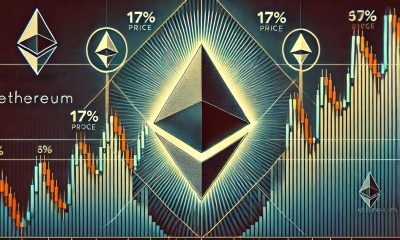
 Ethereum21 hours ago
Ethereum21 hours agoEthereum Consolidates In Symmetrical Triangle: Expert Predicts 17% Price Move
-

 Market20 hours ago
Market20 hours agoToday’s $1K XRP Bag May Become Tomorrow’s Jackpot, Crypto Founder Says
-

 Market18 hours ago
Market18 hours agoMELANIA Crashes to All-Time Low Amid Insiders Continued Sales
-

 Altcoin23 hours ago
Altcoin23 hours agoWhat’s Up With BTC, XRP, ETH?
-

 Market19 hours ago
Market19 hours agoCharles Schwab Plans Spot Crypto Trading Rollout in 2026
-

 Market15 hours ago
Market15 hours agoVOXEL Climbs 200% After Suspected Bitget Bot Glitch
-

 Ethereum23 hours ago
Ethereum23 hours agoEthereum Accumulators At A Crucial Moment: ETH Realized Price Tests Make-Or-Break Point










